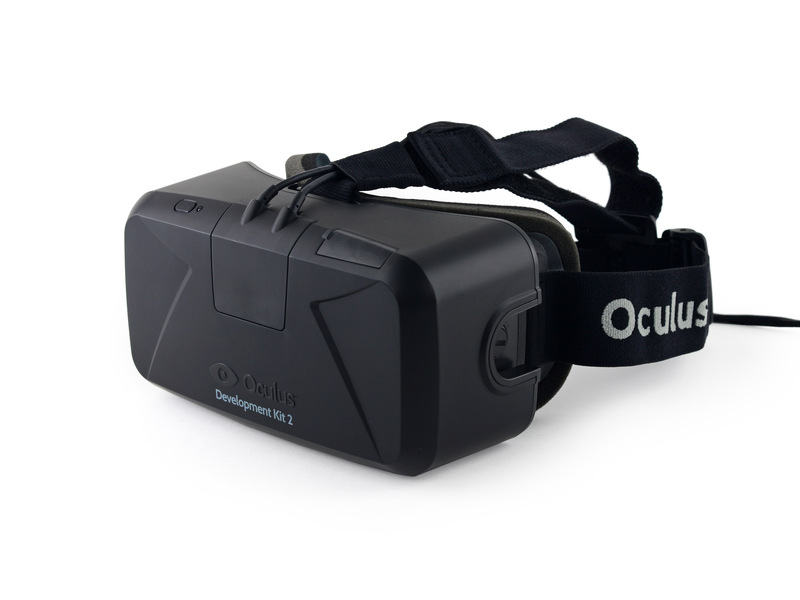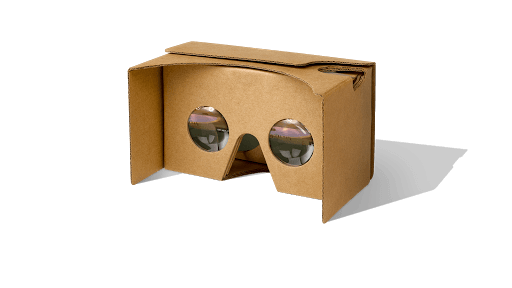Digital technologies/Virtual reality/Virtual reality- Beginner
Virtual Reality (VR) is a system available at the Richard L'Abbe Makerspace which immerses users in virtual 360 environments. These environments can be in the form of 360 videos, 3D application projects (made in Unity or Unreal), or augmented reality (AR).
The Makerspace currently possesses two major VR systems: the Oculus Rift DK2 and the HTC Vive. Other VR and AR systems available include the Google Cardboard and Xbox Kinect.
What is Virtual Reality (VR)?
Virtual Reality is a computer generated 3-dimensional simulation of a game or environment. The simulation is typically run on a device such as a computer, game console or smartphone, and the information is then sent to a VR headset.
Available Systems in Makerspace

Oculus Rift DevKit2
The Oculus Rift system is a VR head-mounted display (HMD) system that is owned by Facebook Inc. The Development Kit 2 was introduced in 2014 and allowed developers to begin creating applications prior to the official release of the Oculus Rift system. The DevKit2 only supports positional tracking in the form of head movement within a small radius, and does not provide controllers or remotes to allow users to interact with their environments.
The headset has a 980x1080 (per eye) resolution, provided by a modified Samsung Galaxy Note 3 acting as it's screen.
HTC Vive

The HTC Vive is a full room-tracking VR system that includes one HMD, two handheld controllers, and two (or more) lighthouse base stations to track user positional data. The system was released in 2016 and became a very popular system due its robustness and immersive experience. The system was developed by HTC and Valve Corporation, and thus a developer package was released by Valve coined "SteamVR" to allow developers to create applications on the headset using the Unity game engine.
The headset has a 1080x1200 (per eye) resolution, a 90 Hz refresh rate, and a 110 degree nominal field of view. The headset also supports users wearing non-bulky glasses while playing by adjusting the headstrap, focal distance, and eye distance.
Adjusting Headset for Usage
If you would like to adjust the headset for your personal comfort, several steps can be taken to get the best possible experience. Note: a tight fit is imperative for a non-blurry experience.
- To adjust the head size, undo the velcro on the left and right side of the headset. Once you put the headset on, pull both straps with equal force until the fit is tight, and then fasten the velcro again.
- To adjust the head size from the top for users with head garments or tied-up hair, undo the velcro on the top side of the headset. Once you put the headset on, pull the strap until it fits with your head size and doesn't slip off.
- To adjust the focal distance between the lenses and screen, locate the two mount points on either side of the headset (where the straps meet the display body) and pull the two gray dials outward. Once you've done so, turn both dials simultaneously either forward or backward until the image appears clear.
- To adjust the distance between eyes, locate the small adjustment dial on the lower-right side of the headset's display. With the headset on your head, turn the dial in either direction to adjust the distance between eyes. The exact distance modified will be shown on the HMD screen when the system is on. Adjust until image is visually clear.

Google Cardboard
The Google Cardboard is a lens display for most modern smartphone devices with built in gyroscopes. By inserting your phone into the headset and enabling VR mode, the HMD becomes a non-positional tracking 360 degree viewer that allows the viewing of 360 videos or scenarios.
Smartphone Setup for 360 YouTube Videos
In order to view 360 degree videos on the official YouTube app, follow the steps outlined below:
- Download the official YouTube app from the Appstore (IOS), Play Store (Android), or your smartphones personal app marketplace.
- Open the app and locate a video that is a 360 degree video.
- In the lower right corner of the video player, tap the Google Cardboard icon. A white bar should now appear in between the video.
- Place the phone in the cardboard and align the center of the headset with the white line on the video.
- Press play and fasten the velcro.
Equipment and Systems
What are VR headsets?
A VR headset is a fully immersive device that is worn on your head; the device contains multiple sensors such as the gyroscope to help calibrate the movement in the simulation with your actual movement. There is a few different types of headsets:
Standalone
Standalone headsets are able to work independently of an external device such as a PC or gaming console. They have their own system that is able to power and run the simulation.
Tethered
Tethered headsets are used in collaboration with another device such as a PC or gaming console. These headsets act as the screens and sensor for the simulation however the actual image processing occurs within the external device. You are also able to get very basic VR headsets that can be used with your smartphones screen to create a virtual Environment.
Other VR Devices
Over time many various other devices have been created that allow you to interact with a VR simulation, for example, there are controllers shaped like weapons that interact with first-person combat games, additionally there are also vests that simulate sensations occurring in the simulation via vibration or temperature.
Uses for VR
VR is becoming increasingly useful for education and training, VR trainings in medicine allow students to interact with and experience various scenarios that give them a greater understanding of a subject.
What is Steam?
Steam is an online gaming library; it allows you to get access to and purchase various games that can be played on the PC. Many free and paid games can be found on the platform for you to use. Because using a VR headset requires the system to output the video to the headsets in a specific manner, SteamVR is used to play the VR games through your PC. The application is compatible with the HTC Vive, Oculus Rift and etc.,
There are other softwares that can be used with the VR headset such as Littlestar, VRWorks, G2 Deals and etc, which software you would use is dependent on a few criteria, such as what kind of experience do you want from virtual reality, and if you would like to consume or create content.
Tutorials on VR Development
Other resources